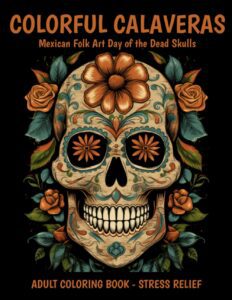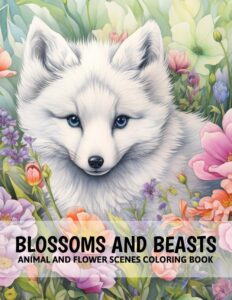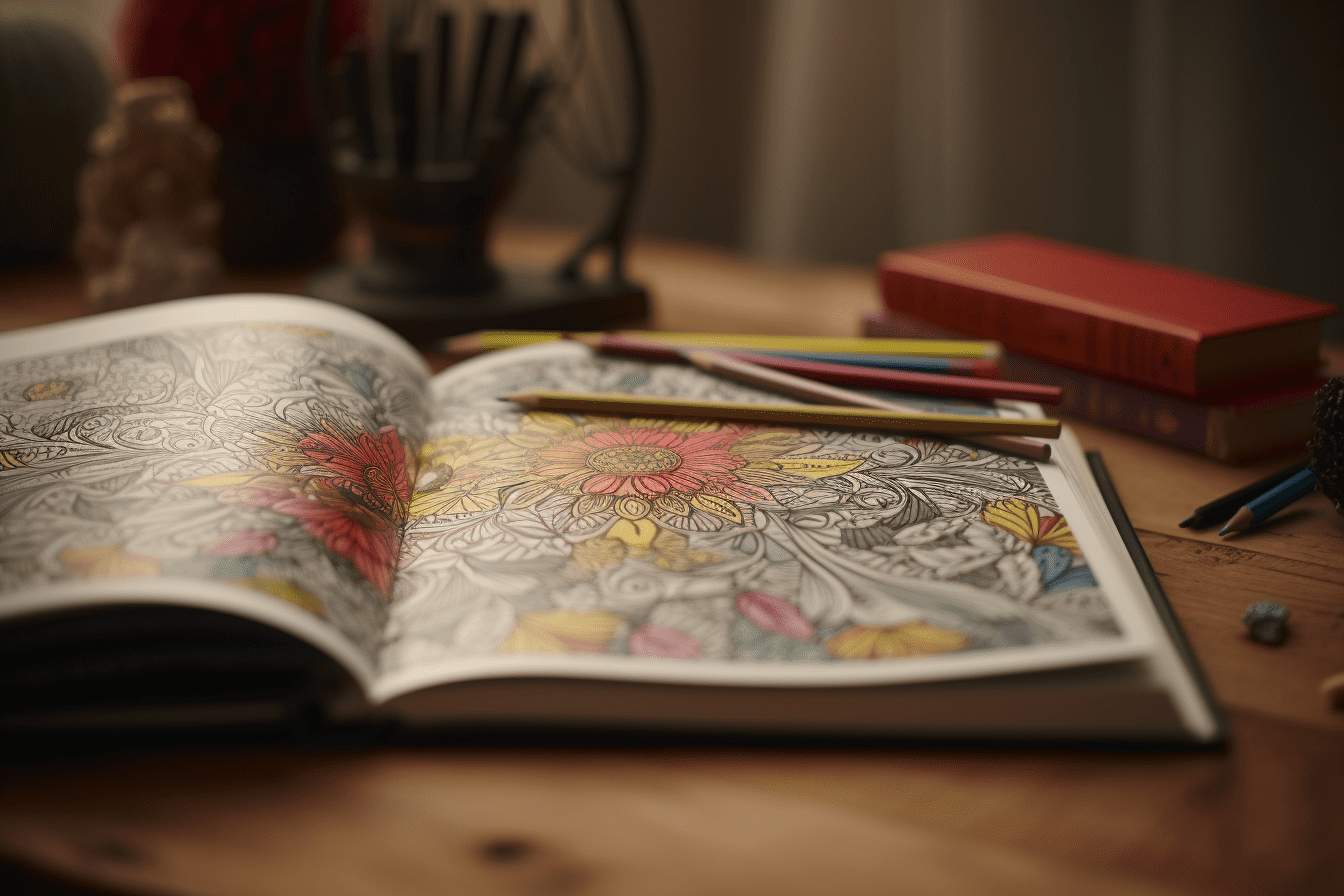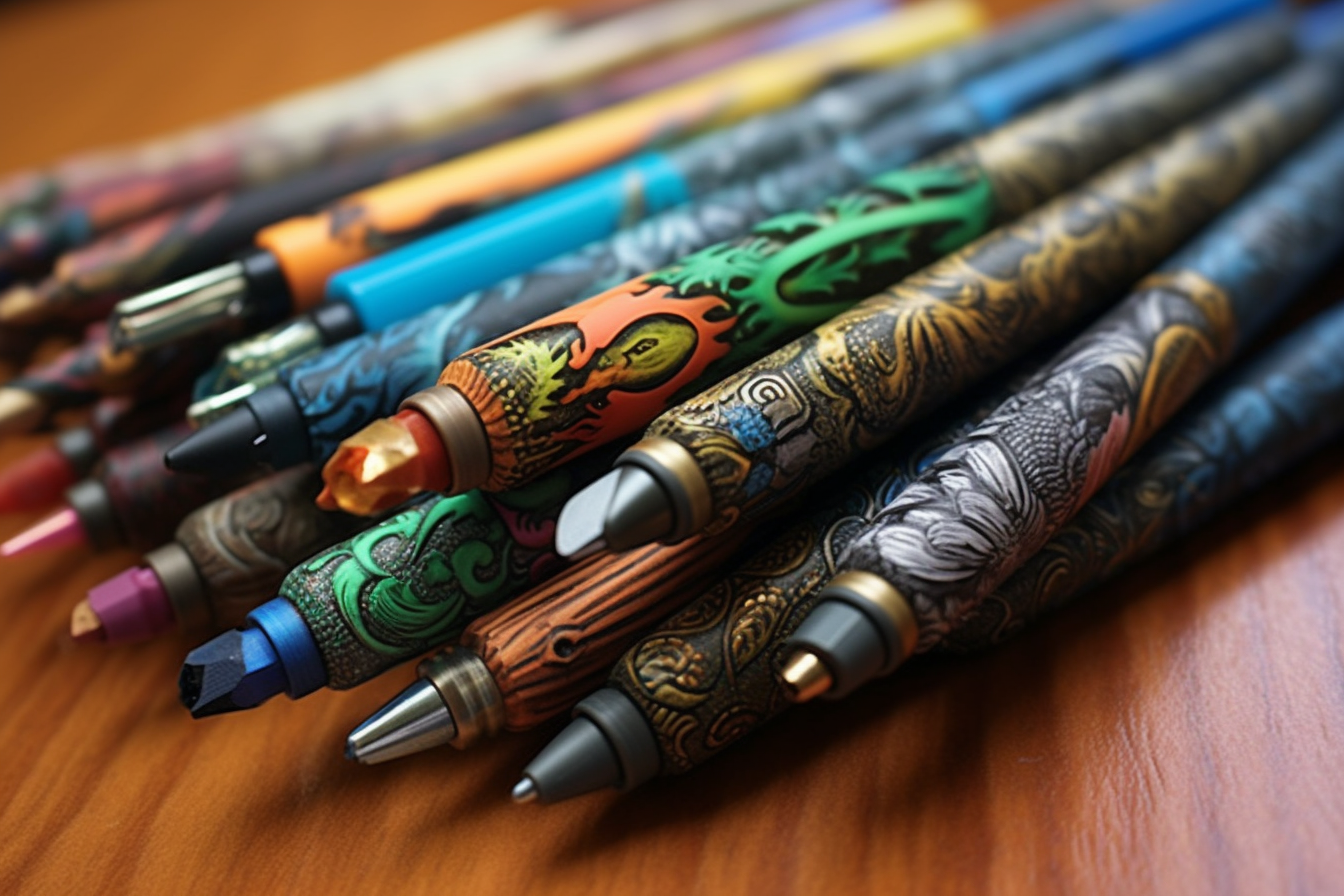Coloring Wars: Colored Pencils vs. Markers – Which Will Make Your Art Shine?

When it comes to the world of adult coloring books and art projects, the debate between colored pencils vs markers is a common one. Deciding between colored pencils and markers can be a challenging task, as both offer distinct advantages and drawbacks. In this blog post, we will explore the benefits and drawbacks of each tool, helping you make an informed decision on which medium best suits your artistic needs.
We’ll delve into precision control with colored pencils as well as blending capabilities due to wax-based binders. On the other hand, we’ll examine markers’ smooth application with liquid ink technology and high-quality results using alcohol-based markers like Copic.
Additionally, we’ll discuss Prismacolor options such as fine-tipped instruments and drying time considerations when selecting tools. Layering techniques with mixed media will also be covered in-depth so that you can combine colored pencils vs markers effectively for painting-like results.
Finally, our guide will help you select the right tool for your project by factoring in personal preferences, budget considerations, and desired coloring effects. By understanding these aspects thoroughly before starting your artwork or purchasing supplies,
Table of Contents

Colored Pencils and Their Advantages
When it comes to coloring tools, colored pencils have always been a popular choice for artists and hobbyists alike. They offer numerous benefits that make them an ideal option for creating beautiful artwork in adult coloring books.
Control over Color Values and Gradients
Colored pencil techniques allow you to achieve greater control over color values, making it easier to create smooth gradients and other effects. With their sharp point, colored pencils enable precision when working on intricate details or delicate shading techniques.
Affordability and Versatility
In comparison to high-end colored pencils like Copic markers, most colored pencils are quite affordable without compromising on quality. Colored pencils’ affordability allows for artists of all calibers to experiment with various mediums without the financial strain.
Superior Blending Capabilities
- Wax-based colored pencils: Wax-based binders used in these types of colored pencils provide better blendability than oil-based ones due to their softer texture.
- Pigments: The pigments found in colored pencils offer more nuanced shades compared with marker’s ink, allowing you to mix colors directly on paper.
In addition, using multiple layers of color application can help achieve a richer depth of tone not possible with markers alone. Whether you’re new to the world of adult coloring books or looking for ways to improve your skills further, consider giving colored pencils a try – they might just become your go-to coloring tool.
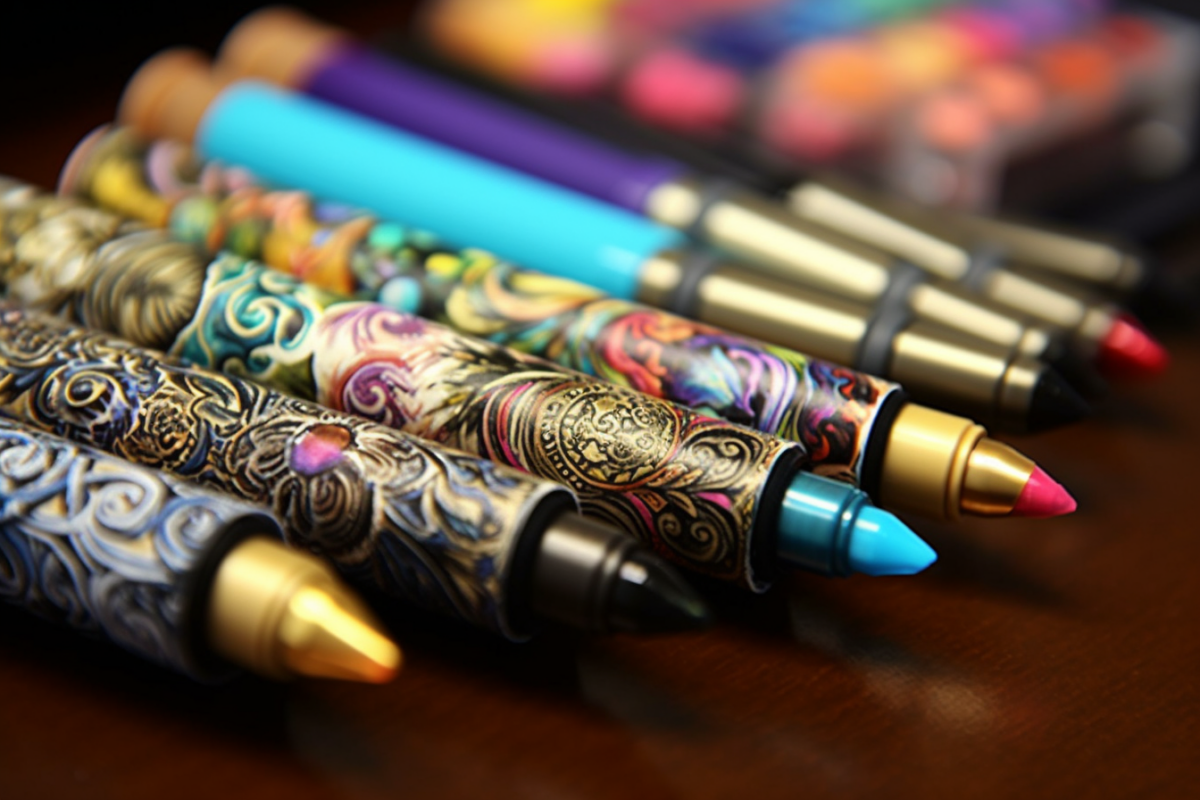
Markers – Crisp Colors and Smooth Coloring Experience
Markers provide a unique coloring experience with their ability to produce vibrant hues and smooth color application. They are an excellent choice for those who prefer bold colors and want to avoid the hassle of pencil shavings.
Vibrant colors with smooth application
The marker’s ink is liquid, allowing it to fill in all the tiny crevices of paper, resulting in a higher quality outcome compared to graphite found in colored pencils. This characteristic makes markers ideal for adult coloring books that require crisp, clean bodies of color.
Alcohol-based vs alcohol-free markers
Alcohol-based markers, such as Copic markers, offer superior blending capabilities compared to alcohol-free alternatives. The ink dries quickly and produces high-quality uniform colors perfect for creating tints, shades, and textures. Yet, these markers can be pricier than water-based ones.
Creating tints, shades, and textures
- Tints: Lighten your marker’s ink color by adding layers or using lighter shades on top of darker ones.
- Shades: Achieve deeper tones by layering multiple applications of the same color or applying darker hues over lighter ones.
- Textures: Use different types of strokes (dots, lines) or combine various techniques like stippling or hatching to create interesting patterns within your artwork.
Incorporating these marker benefits into your coloring projects will result in stunning visuals full of bold colors and vibrant hues, making them an excellent choice for those who prefer a smooth coloring experience.
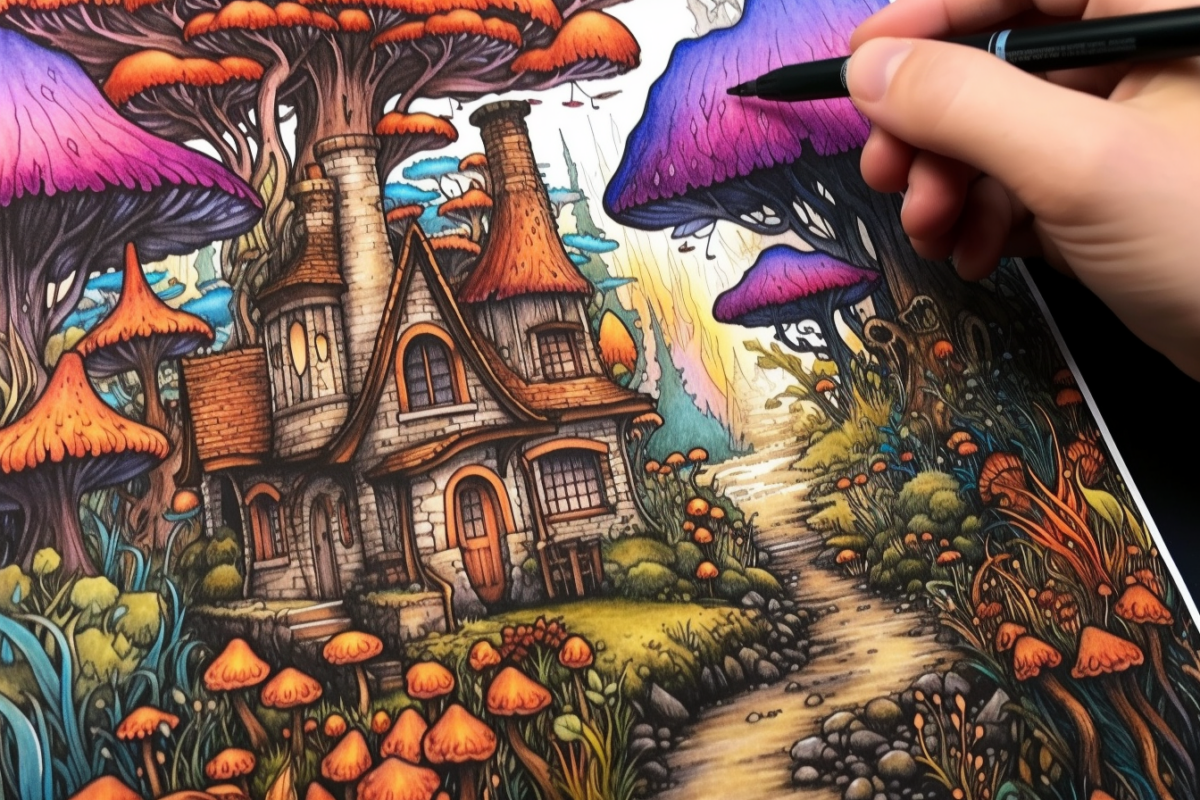
Blender Pens – Mastering Marker Gradients
Modern adult coloring marker sets often come packaged with blender pens designed specifically for mingling neighboring marker colors into a single soft gradient. However, using these pens isn’t as simple as it may appear and takes practice to achieve desired results without compromising on quality.
The Role of Blender Pens in Marker Sets
Blender pens play an essential part in the world of markers by allowing artists to seamlessly blend colors together, creating smooth transitions between hues. These specialized tools are filled with a colorless solution that interacts with the ink from colored markers, making it possible to mix and merge different shades effortlessly. Blender pens can be found in various Copic marker sets, which are popular among professionals and hobbyists alike.
Techniques for Using Blender Pens Effectively
- Flicking: Apply strokes starting at the edge of one color and flick towards the other color. This technique helps create a subtle transition between two adjacent colors.
- Circular Motion: Use small circular motions while applying pressure over both colors simultaneously. This method allows better control over blending but requires more time compared to flicking.
- Dabbing: Dab your blender pen onto both colors repeatedly until they begin merging together naturally. Be cautious not to oversaturate paper or damage its surface during this process.
Incorporating these techniques will help you make full use of your blender pens, enhancing the overall appearance and quality of your adult coloring book projects.
High-Quality Options from Prismacolor
Prismacolor offers high-quality options catered towards individual needs when it comes to the debate between colored pencils and markers. Some coloring books contain lots of detail requiring well-sharpened fine-tipped instruments like Copic, while others need long-lasting ink that won’t bleed through thin paper and require drying time before moving forward.
Fine-Tipped Instruments for Detailed Work
The Premier Colored Pencils by Prismacolor are an excellent choice for those who prefer working with colored pencils. These wax-based colored pencils offer a wide range of vibrant hues and superior blending capabilities, allowing artists to create intricate details in their adult coloring books. The sharp point on these pencils enables users to achieve precise lines and shading techniques that may be difficult with other tools.
Long-Lasting Ink That Won’t Bleed Through Thin Paper
In contrast, if you’re looking for markers that provide bold colors without bleeding through thin pages, consider using the Premier Brush Fine Art Markers. These alcohol-based markers deliver smooth color application while minimizing bleed-through issues commonly associated with liquid ink. Additionally, they come in various shades suitable for creating stunning effects in your coloring projects.
To make the most out of your chosen tool, always ensure proper care and maintenance such as keeping pencil shavings away from artwork or storing markers horizontally to prevent uneven distribution of ink color.

Layering and Mixed Media Techniques
Improved layers and mixed media are possible by utilizing the advantages of each tool, resulting in vibrant painting-like results. When drawing, one can achieve the same level of control they are familiar with while practicing techniques using less expensive Premier Pencils.
Combining Colored Pencils and Markers
To create stunning artwork that showcases both bold colors and intricate shading techniques, try combining colored pencils with markers. Start by laying down a base layer of marker ink to establish vibrant hues quickly. Next, use colored pencils to add depth through shading or highlighting specific areas.
Exploring Layering Techniques
- Burnishing: Apply heavy pressure when coloring with your pencil to blend colors seamlessly into the paper’s surface for a polished look.
- Grisaille: Create an underpainting using gray-scale values before adding color on top for increased depth perception (source).
- Cross-hatching: Use intersecting lines from different directions to build up texture and tone gradually (learn more about this technique at this guide on cross-hatching tips).
- Frottage: Place textured objects beneath your paper as you color over them with a pencil, transferring their patterns onto your work (source).
Experimenting with these layering techniques will help you unlock the full potential of your colored pencils and markers, leading to more dynamic and visually appealing artwork.
Wax-Based vs Oil-Based Binders
The type of binder used in colored pencils can greatly impact their performance and the final result of your artwork. This article will examine the advantages and drawbacks of wax-based versus oil-based binders in relation to coloring books.
Characteristics of Wax-Based Binders
Wax-based colored pencils are known for their softness, which allows for easy application of pigment on paper without much pressure. This characteristic is particularly beneficial when working with adult coloring books that require a lighter touch to avoid damaging the paper or causing unwanted indentations. Additionally, wax-based colored pencils offer excellent blendability due to their softer nature, making it easier to create gradients and shading techniques.
Comparing Wax-Based and Oil-Based Binders
- Vibrancy: Both types of binders produce vibrant hues; however, oil-based colored pencils tend to have a slightly higher level of saturation compared to wax-based ones.
- Durability: Oil-based binders generally provide better resistance against breakage than wax-based counterparts since they are harder in composition.
- Ease-of-use: While both types allow for smooth color application, some artists find that oil-based colored pencils require more effort during blending due to their firmer texture.
- Pencil shavings: Since oil-bound pigments are denser than those bound by wax, users may experience fewer pencil shavings while sharpening an oil-infused tool compared with its waxy counterpart.
Ultimately, the choice between wax-based and oil-based binders in colored pencils comes down to personal preferences and desired effects. By understanding the differences between these two types of binders, you can make an informed decision that best suits your coloring needs.
Choosing the Right Tool Based on Project Details
Selecting the most suitable coloring tool based on factors such as preferences, budget, desired effects, and project details is essential for achieving optimal results. One can switch back and forth depending on the feeling and design required while considering various aspects like blending capabilities or fine detailing needs.
Factors Influencing Choice Between Colored Pencils and Markers
- Preferences: Some artists prefer the control that colored pencils offer, while others enjoy the bold colors and smooth application of markers.
- Budget: High-end colored pencils can be expensive but are often more affordable than premium alcohol-based markers like Copic. Consider your budget when choosing between these two options.
- Desired Effects: If you’re looking to create vibrant hues with crisp lines, markers may be a better choice. However, if you want to blend colors seamlessly or achieve detailed shading techniques, colored pencils might suit your needs better.
- Project Details: The type of paper used in adult coloring books varies greatly; some have thick pages that work well with both tools while others require a lighter touch from wax-based colored pencils to avoid bleed-through issues caused by marker’s ink.
Adapting Tools According to Project Requirements
In order to make an informed decision about which tool is best suited for your specific project requirements, it’s important not only to consider personal preference but also to take into account how each medium will interact with different types of paper surfaces found within adult coloring books. Exploring the use of colored pencils and markers can aid in selecting the most suitable tool for achieving your artistic objectives, taking into account various paper surfaces within adult coloring books.
FAQs in Relation to Colored Pencils vs Markers
Are Colored Pencils Better Than Markers?
Colored pencils and markers each have their own advantages, making it difficult to declare one as universally better. Colored pencils offer precision, control, affordability, and blending capabilities. Markers provide smooth application, high-quality results with alcohol-based options, and seamless gradients using blender pens. The choice depends on personal preferences and the desired outcome of your project.
What Is an Advantage of Using Colored Pencils on Top of Markers?
Using colored pencils over markers allows for greater depth in your artwork by combining the vibrant colors from markers with the subtle shading capabilities of colored pencils. This mixed media approach can create painting-like effects that are not achievable when using either medium alone.
What Are the Disadvantages of Using Colored Pencils?
- Limited color intensity compared to some marker types
- Potential wax bloom or buildup
- Frequent sharpening may be required
- Sometimes more time-consuming than other mediums
What Are the Benefits of Colored Pencils?
- Precision and control during application
- Affordability compared to professional-grade art supplies
- Ease-of-use for beginners or experienced artists
- Variety in available techniques such as layering and blending
Conclusion
When it comes to selecting between hued pencils and markers, both can be advantageous depending on the task at hand. Colored pencils offer precision and control, affordability, and blending capabilities due to wax-based binders. On the other hand, markers provide smooth application with liquid ink technology, high-quality results using alcohol-based options, and blender pens for seamless gradient effects.
By combining these tools effectively through layering techniques with mixed media such as Prismacolor options or starting out with Premier Pencils for practice, artists can achieve painting-like results that suit their personal preferences and desired coloring effects while factoring in budget considerations.
If you’re looking to explore your artistic side further with colored pencils vs markers or any other art supplies for that matter, visit Lifetime Coloring Books. Lifetime Coloring Books provides a vast selection of coloring books for all ages.



